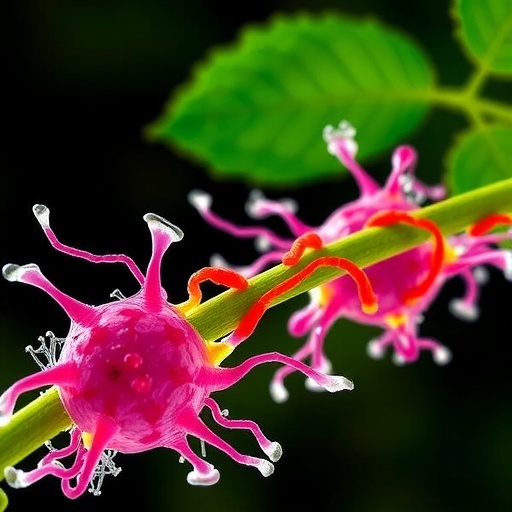In a groundbreaking advance in plant cell biology, researchers at Japan’s National Institute for Basic Biology have unveiled a previously undiscovered trafficking pathway that retrieves membrane proteins from the vacuole back to endosomal compartments in plants. This breakthrough illuminates a novel retrograde transport system unique to plants, reshaping our understanding of intracellular membrane dynamics essential for plant development and seed physiology. The study, recently published in Nature Plants, centers on the model organism Arabidopsis thaliana and provides the first molecular characterization of a vacuole-to-endosome recycling pathway mediated by sorting nexin proteins and unique SNARE complexes.
Vacuum-like organelles called vacuoles have long been recognized for their dual role in plant cells. Similar to lysosomes in animal cells and yeast, plant vacuoles perform degradative functions, breaking down unwanted or damaged cellular components to maintain homeostasis. Yet, in seed tissue, these organelles also act as reservoirs of storage proteins that fuel the nascent seedling during germination. These massive accumulations of proteins in vacuoles of beans, wheat, and related crops represent fundamental agricultural importance, linking molecular transport mechanisms to global food resources. Despite extensive study on vacuolar protein import and degradation, the converse transport—movement of proteins out of the vacuole—remained elusive until now.
The research team, led by Dr. Yihong Feng and Professor Takashi Ueda, has demonstrated that vacuolar membrane protein VAMP727 undergoes retrograde trafficking, recovering from the vacuolar membrane and redirecting back to endosomal compartments. This observation challenges traditional views that traffic within plant cells is largely unidirectional toward degradation once proteins reach the vacuole. Instead, this newly characterized pathway allows the cell to recycle specific vacuolar membrane components, maintaining organelle identity and function. Their findings suggest a sophisticated and dynamic model of membrane protein distribution finely tuned within plant cells.
Crucially, this transport route diverges mechanistically from those in yeast and animals. In these systems, sorting nexins and core retromer complexes coassemble into a single unit facilitating endosome-to-Golgi retrograde trafficking. However, the study uncovers that in plants, sorting nexin proteins (SNX) and the core retromer machinery function independently, delineating two separate pathway branches. One branch is SNX-mediated and highlighted in orange, the other reliant on the core retromer depicted in blue—a spatial segregation underscored by different clientele of cargo proteins serviced by each route. This dual-pathway arrangement represents a distinct evolutionary path in the plant lineage.
The vacuolar SNARE protein VAMP727, which possesses specialized plant-unique features, appears integrally linked to this retrograde system. SNAREs are pivotal membrane fusion proteins controlling vesicle docking and fusion specificity. VAMP727’s coevolution with the recycling pathway signifies a tailored mechanism adapted to the unique requirements of seed plant vacuoles, particularly the need to efficiently manage storage protein loads and vacuole membrane composition under varying developmental stages. This adaptation reflects an evolutionary innovation coinciding with the rise of seed plants.
From a molecular perspective, sorting nexins recognize and bind specific phosphoinositide lipids on endosomal membranes, sculpt membranes into tubules or vesicles, and sort cargo proteins for recycling. The plant-specific complement of SNX proteins identified by Feng and colleagues exhibits independent diversification, suggesting functional specialization separate from their animal or fungal homologs. This diversification is likely driven by the necessity to accommodate plant-specific trafficking demands, including the retrieval of vacuolar membrane proteins.
This research opens a new chapter in plant cell trafficking, expanding the known intracellular transport network with a previously unrecognized retrograde flow from vacuoles to endosomes. Such findings have broad implications for cell biology, notably in understanding how membrane heterogeneity and organelle identity are safeguarded in plant cells. It also offers insights into the molecular underpinnings behind the robust storage capabilities of seed vacuoles, directly impacting agricultural traits like seed quality and nutrient storage.
Professor Ueda emphasizes the significance of this discovery, stating that the evolution of vacuolar protein transport mechanisms was closely intertwined with the emergence of this retrograde trafficking pathway. This aligns with the increasing appreciation of plant cells as dynamic entities employing sophisticated recycling and sorting routes beyond canonical pathways derived from animal models. Such plant-specific innovations underscore the evolutionary adaptability of membrane trafficking systems.
Beyond fundamental science, this study could have translational ramifications. Understanding and potentially manipulating the vacuolar recycling pathways could lead to enhanced accumulation and mobilization of storage proteins critical for seed vigor and crop yield. Moreover, the elucidation of distinct retrograde routes offers new targets for bioengineering interventions aimed at optimizing protein trafficking efficiency in plants.
The research carries implications extending to the broader field of membrane trafficking where sorting nexin proteins have been implicated in human disease and neurodegeneration. Comparative studies may uncover conserved molecular principles and divergent evolutionary strategies shaping intracellular transport. Thus, the plant retrograde pathway may provide a fresh biological model revealing fundamental processes applicable to multiple kingdoms of life.
Taken together, the identification and molecular characterization of the plant-specific vacuole-to-endosome retrograde transport pathway represent a major leap in our comprehension of plant endomembrane systems. By revealing independent sorting nexin and retromer-mediated routes coupled to the plant-unique SNARE VAMP727, this study furnishes a comprehensive framework for future exploration of membrane trafficking, organelle biogenesis, and plant developmental biology.
In summary, this landmark research not only fills a critical gap in cell biological knowledge but also exemplifies the complexity and specialty evolved by plant cells. It underscores how unique retrograde membrane trafficking mechanisms support vital physiological functions, such as the maintenance of vacuolar integrity and seed storage capabilities, which are crucial for plant fitness and agricultural productivity worldwide.
Subject of Research: Intracellular retrograde membrane trafficking pathways in plant cells, focusing on vacuole-to-endosome transport.
Article Title: Retrieval from vacuolar/endosomal compartments underpinning neofunctionalization of SNARE in plants
News Publication Date: 3-Oct-2025
Web References:
https://doi.org/10.1038/s41477-025-02115-5
Image Credits: Ueda Lab, National Institute for Basic Biology (NIBB)
Keywords: Plant retrograde trafficking, vacuolar membrane protein recycling, sorting nexin, core retromer, SNARE proteins, VAMP727, Arabidopsis thaliana, endosome-to-vacuole transport, plant cell biology, seed protein storage, membrane trafficking pathways, evolutionary cell biology




